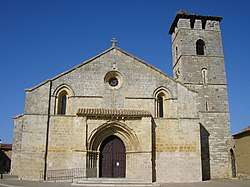Husillos
Husillos is a municipality located in the province of Palencia, Castile and León, Spain. According to the 2004 census (INE), the municipality had a population of 208 inhabitants.
Husillos | |
|---|---|
 | |
 Seal | |
| Country | |
| Autonomous community | |
| Province | |
| Municipality | Husillos |
| Area | |
| • Total | 16 km2 (6 sq mi) |
| Population (2018)[1] | |
| • Total | 313 |
| • Density | 20/km2 (51/sq mi) |
| Time zone | UTC+1 (CET) |
| • Summer (DST) | UTC+2 (CEST) |
| Website | Official website |
Town Holidays
- JULY 3rd Fiesta de la Octava
- AUGUST 5th Fiesta de Verano (Summer)
- DECEMBER 4th Santa Barbara
Tourism: Town Council 0034-979808244 www.dip-palencia.es
Geography
Husillos is a little municipality in Northern Spain, in Castile-León, very close, only 11 km away, from Palencia and about 260 km northwest of Madrid. Husillos has 208 inhabitants and is 16,4 km² in size.
History
Husillos has had dwellers called vacceos of Celtic origin, and then successively the Romans, the Visigoths, Muslims and finally Modern Europeans. The recent history of Husillos starts at the end of the 9th century AD, when the presbiterus Gatón rebuilt the Church of Santa Maria (vid Archivo General de Simancas) that had been destroyed during the Muslim occupation of Palencia (8th and 9th centuries.)
During the 10th century the Abbey of Santa Maria de Fusiellos was built, also called Santa Maria de la Dehesa Brava. In the 11th century the king Sancho el Mayor (Castile) gave the town of Husillos to the Bishop of Palencia, the nearest city. The Middle Ages was the Golden Era for the region of Palencia that comprised Husillos. An important Jewish community lived in the Palencia region during several centuries, although they were finally forced to leave for political and religious reasons in 1492. In the 16th century and after the Battle of Saint Quentin that ended on Saint Laurent's day, AUGUST 10th 1557, Philip II of SPAIN built the Palace of San Lorenzo del Escorial, near Madrid. The king asked the Abbot of Husillos whether he could give the relic of Saint Laurent, his foot, for the palace of El Escorial. The Abbot gave him it as a present.
In the 16th century the abbey was moved to Ampudia (Palencia).
In the beginning of the 19th century, Husillos was briefly ruled, 5 years, by Napoleon's FRANCE.
In the Museum of Archaeology in Madrid we can find a Roman sarcophagus from II A.D. with the Myth of Orestes as decoration. It is a piece imported from Rome and found in Husillos. It was reused in the year 960 as the burial of the Count of Monzón Fernando Ansúrez. It was found in Husillos in the 19th century. The Church of Husillos is a National Monument since 1931.
Climate
The climate of Husillos is continental with extremes in winter of -15.C and 40.C in summer.
Education
Some 30 years ago people went to school in Husillos, now the few kids who live in Husillos go to school in Palencia. Most of them either work on agriculture or study at the University of Valladolid that is only 50 km away. The rest try to find a space in the homebuilding business.
Religion
99% of the inhabitants of Husillos are Roman Catholics, although the new generations are not as fervent as their parents and grandparents. This part of Spain has always had a very strong Roman Catholic influence and still does.
Economy and Demographics
In the last century one hundred farmers worked in the fields of Husillos. With the advent of the new technologies, the inhabitants from Husillos understood that they had to migrate to the cities, mainly Palencia, Valladolid, Bilbao and Madrid. Later on, people working in Palencia came to live to Husillos (11 km. away from Palencia). Some of them started small building companies. Today, the farmers are old, mostly retired and only a dozen of young farmers continue working in Husillos thanks in part to some European Union subsidies. Farmers mainly grow wheat, barley, corn, hay(alfalfa), rapeseed(canola) and sugar beat. Historically Husillos had a population of around 400 inhabitants. Today there are some 215 of them, although the real estate promoters are making important efforts marketing Husillos as a burgeoning suburb of Palencia. As in most villages in Castille, the population increases considerably in summer. The (GDP) per capita PPP of the province of Palencia is of around 23000 euros (2011).
Politics
The conservative Partido Popular has been ruling in Husillos since the party was created after the death of General Franco. Husillos is the typical village of Castilla y León, where the conservatives are in the government for more than 20 years. although in the most recent municipal elections the PSOE Party has won the elections and the current mayor is from the PSOE Party. The PSOE Party is social democrat.
Sports
The kids play football(soccer), basketball in a small outside court and frontennis against a big 7 meters high wall. The main sport is hunting with dogs. The most coveted preys are hares, partridges and quails. Many years ago foxes were hunt, but not with dogs and horses, but rather on foot, alone. The legend says that one hunter after the Spanish Civil War (1936-1939) hunted 12 foxes in a single day, alone, by himself. He was the Judge of Peace of Husillos during 30 years. His name was Rafael GATÓN MOLLEDO, (1893-1987).
Leisure
The Husillos most common pastime is to play cards, namely mus, brisca, tute. Both men and women play cards, although normally separately. They also play domino. Nearly every day the old farmers of the town gather informally to hear the same old stories... The internet has been made readily available through radio waves with a maximum speed of 4 megas.
References
- Municipal Register of Spain 2018. National Statistics Institute.